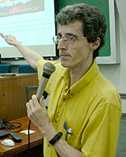Mass in Relational Mechanics
Year: 2000 Pages: 2
Keywords: mass density of distant galaxies, free fall, inertial mass density v gravitational mass
In (Assis 1998, pp. 241-249) and (Assis 1999, pp. 199-205) it was said that if we double the average matter density of the distant universe (galaxies), while keeping constant the matter density of the earth and all sizes and distances, the acceleration of free fall halves (that is, goes to 4.9m/s2 instead of the usual 9.8m/s2). Guala-Valverde concluded that in this case the acceleration of free fall should go to (9.8m/s2) / 2, see (Guala-Valverde 1999a and 1999b, p. 25). But this was only due to a misunderstanding. Guala-Valverde was thinking on doubling the average inertial mass density of distant galaxies, while Assis was talking of doubling the average gravitational mass density of distant matter (see (Assis 1998, pp. 207, 211 and 246) or (Assis 1999, pp. 170, 174 or 204). This solves all misunderstandings. That is, Guala-Valverde and Assis agree that doubling the gravitational mass density of distant matter (while keeping unalterable Hubble's constant, the gravitational mass of the earth and its radius) will make the acceleration of free fall go to 4.9 m/s2. So our results are not clashing, it was all due to a misunderstanding.



